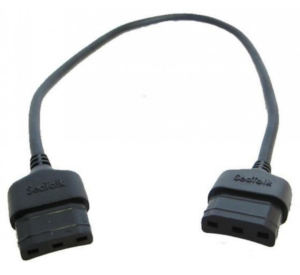
Fig.: SeaTalk connection technology
SeaTalk is a Raymarine proprietary serial network protocol developed in the 1980's and used for the transmission of navigation data and other information on boats. The data is transmitted as compact binary data. SeaTalk uses a single wire connection as the data line for serial data transmission, meaning that it is both sent and received bit by bit over a single wire. Implementation is extremely simple, since in addition to the data line, only two additional lines are required for the supply voltage. All devices are simply connected in parallel to the data bus.
SeaTalk benefits:
- Higher data rates: SeaTalk can transmit more data than NMEA0183 at 4800 Bd due to compact binary data transmission.
- Bi-directional transmission: SeaTalk offers bi-directional transmission, allowing data to be both sent and received on the single wire connection.
- Reliability: SeaTalk is a reliable network protocol that guarantees data is transmitted correctly. To do this, checksums are used for the telegrams.
- Simple Wiring: Units are easy to add to a SeaTalk bus. Most devices use an input and an output port with which the bus can be forwarded to other devices. In this way, many devices can be easily integrated.
Disadvantages of SeaTalk:
- Proprietary: SeaTalk is a proprietary protocol not supported by any other manufacturer. It is only compatible with Raymarine devices.
- Expensive connection technology: SeaTalk uses its own proprietary connector format, which is quite expensive.
- Lack of extensibility: SeaTalk cannot be expanded with new data content or data formats. The data transmission is designed purely for sensor data. Image data or other large amounts of data cannot be transmitted over SeaTalk.
- Limited bandwidth: Due to the fixed baud rate of 4800 Bd, an unlimited amount of data cannot be transmitted.
Overall, SeaTalk is a reliable and integrity network protocol for transmitting sensor and navigation data on boats, but it has limitations, particularly in terms of compatibility and bandwidth. From today's perspective, SeaTalk is outdated and is often replaced by more powerful bus systems such as NMEA2000. Many boat owners still use SeaTalk devices as they have proven to be very robust and durable devices.
See also SeaTalk NG, the successor to SeaTalk.
open-source
SeaTalk has been heavily used by Thomas Knauf analyzed and realized some implementations for PC systems. Based on his analyzes and findings, a SeaTalk C library created for microcontrollers by James Roscoe, with which a gateway functionality is made available.